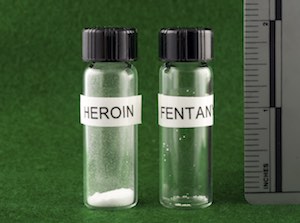 With permission from Bruce Taylor/NHSP Forensic Lab Image showing lethal doses of heroin (left) and fentanyl (right)
With permission from Bruce Taylor/NHSP Forensic Lab Image showing lethal doses of heroin (left) and fentanyl (right)Every day, 91* Americans fatally overdose on an opioid drug. It may be a prescription analgesic or heroin—4-8 percent of people who misuse painkillers transition to heroin—but increasingly it is likely to be heroin’s much more potent synthetic cousin fentanyl. In the space of only two years, fentanyl has tragically escalated the opioid crisis. This drug is 50-100 times more potent than morphine and able to enter the brain especially quickly because of its high fat solubility; just 2 milligrams can kill a person, and emergency personnel who touch or breathe it may even be put in danger. Unfortunately, many people addicted to opioids as well as other drugs like cocaine are accidentally being poisoned by fentanyl-laced products.
Although fentanyl is a medicine prescribed for post-surgical pain and palliative care, most of the fentanyl responsible for this surge of deaths is made illicitly in China and imported to the U.S. via the mail or via Mexican drug cartels. Its high potency and ease of manufacture make it enormously profitable to produce and sell. According to the DEA, one kilogram of fentanyl can be purchased in China for $3,000 to $5,000 and then generate over $1.5 million in revenue through illicit sales in the U.S. Thus distributors of illicit drugs are eager to adulterate heroin or cocaine powder with fentanyl or put it in counterfeit prescription drugs, such as pills made to look like prescription pain relievers or sedatives. Last month, for example, a wave of deaths in Florida was linked to fake Xanax pills containing fentanyl.
Deaths from fentanyl and a handful of other synthetic opioids tripled from 3,105 in 2013 to 9,580 in 2015, and those numbers are likely underestimates; some medical examiners do not test for fentanyl and many overdose death certificates do not list specific drugs involved. Thus far, New Hampshire has recorded the most fentanyl overdoses per capita; a NIDA-funded HotSpot study found that in 2015, almost two thirds of the 439 drug deaths in that state involved fentanyl.
Although most who fatally overdose on fentanyl are unaware of what they have taken, news of such fatalities has driven some people with severe opioid addictions to seek it out. Part of the cycle of an opioid use disorder is increased tolerance, causing diminished response to the drug, which leads users to seek products with higher potency so they can experience the euphoria they initially felt. Roughly a third of opioid users interviewed as part of the HotSpot study in New Hampshire knowingly sought fentanyl.
The fentanyl problem is already a high priority for policymakers. Last month, NIDA’s Deputy Director Wilson Compton testified before Congress on the science of fentanyl, accompanied by representatives from the DEA, the Office of National Drug Control Policy (ONDCP), the CDC, and other agencies. Diplomatic and law enforcement efforts to cut off the supply of illicit fentanyl and the chemicals needed to manufacture it will be important, but the emergence of very high potency opioids—which can be transported in smaller volumes—will make addressing supply increasingly difficult. Thus, a public health strategy to address the opioid crisis and overdose epidemic is more important than ever.
First, we must improve pain management and minimize our reliance on existing opioid pain medications. Second, treatment centers and healthcare systems must make much wider use of available, effective medications for opioid addiction (buprenorphine, methadone, and extended-release naltrexone). Third, the opioid-overdose reversing drug naloxone needs to be made as widely available as possible, both to emergency first responders as well as to opioid users and other laypeople who may find themselves in a position to save a life. In cases of fentanyl overdose, multiple doses of naloxone may be needed to reverse an overdose and additional hospital care may be needed. And all individuals who overdose on opioids need to be linked to a treatment program to prevent it from happening again.
Only by mobilizing healthcare systems to deliver effective prevention and treatment of substance use disorders, utilize naloxone to prevent and reverse overdoses, and develop safe effective treatments for the management of chronic pain will we be able end the current opioid crisis, as well as prevent it from happening again.
*Update: Overdose rates seen in 2018 are more than 115 a day